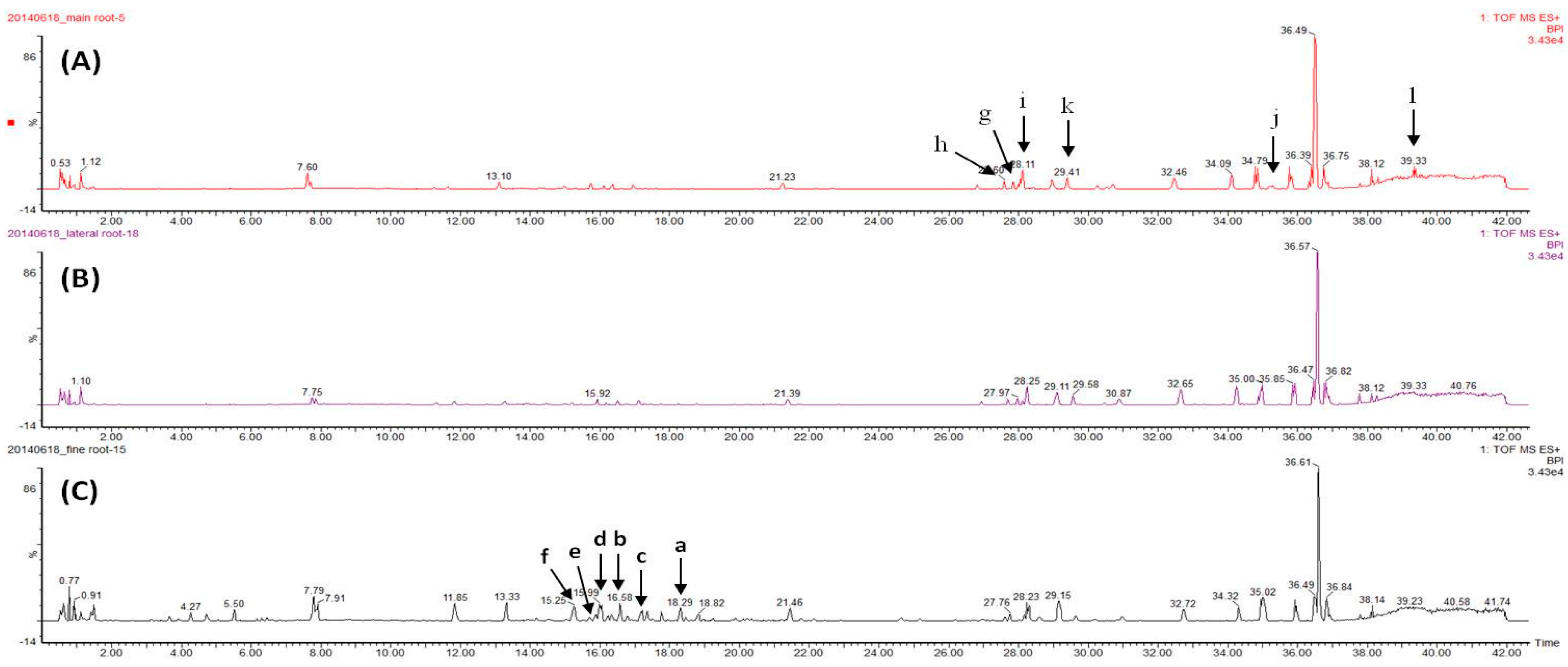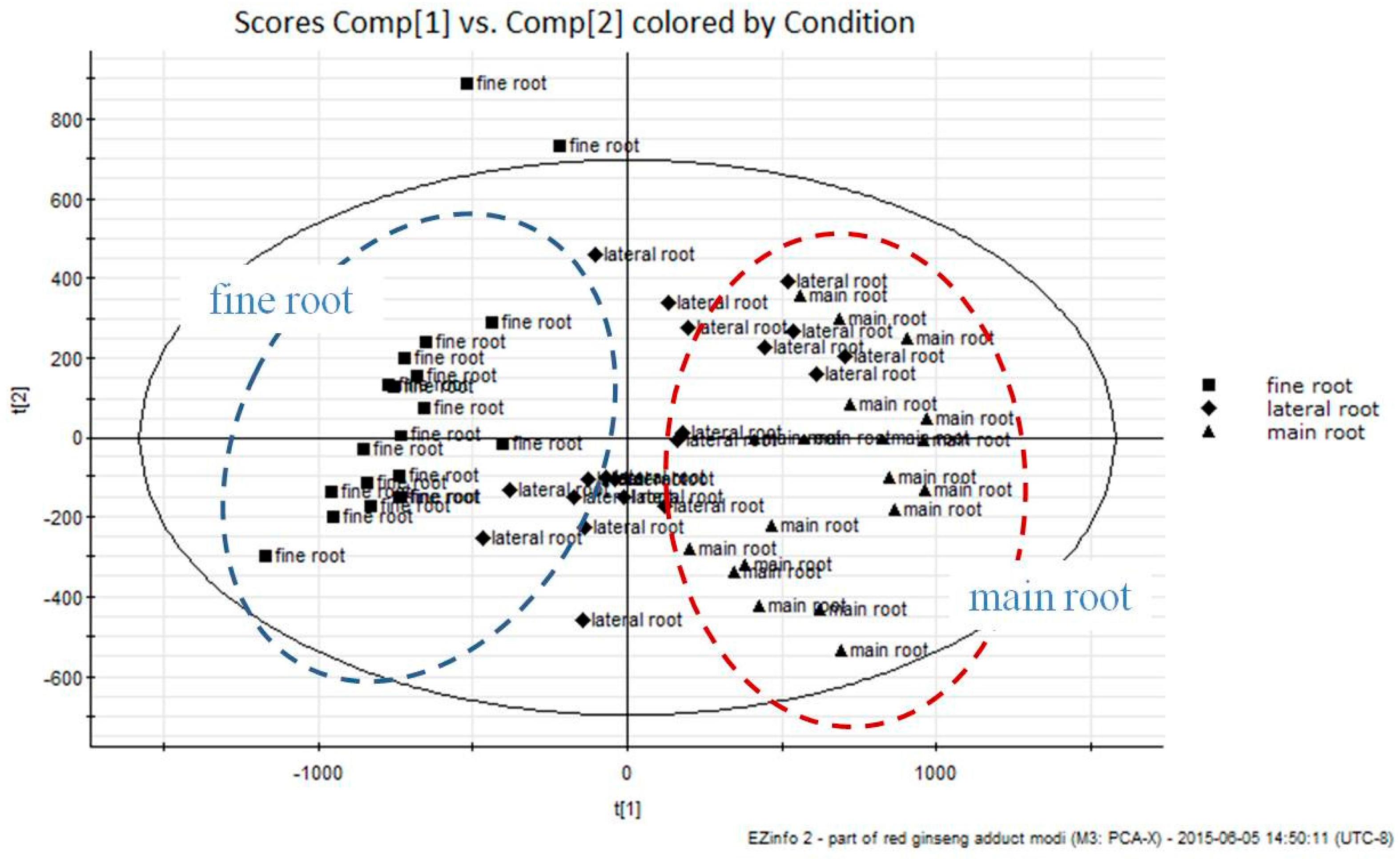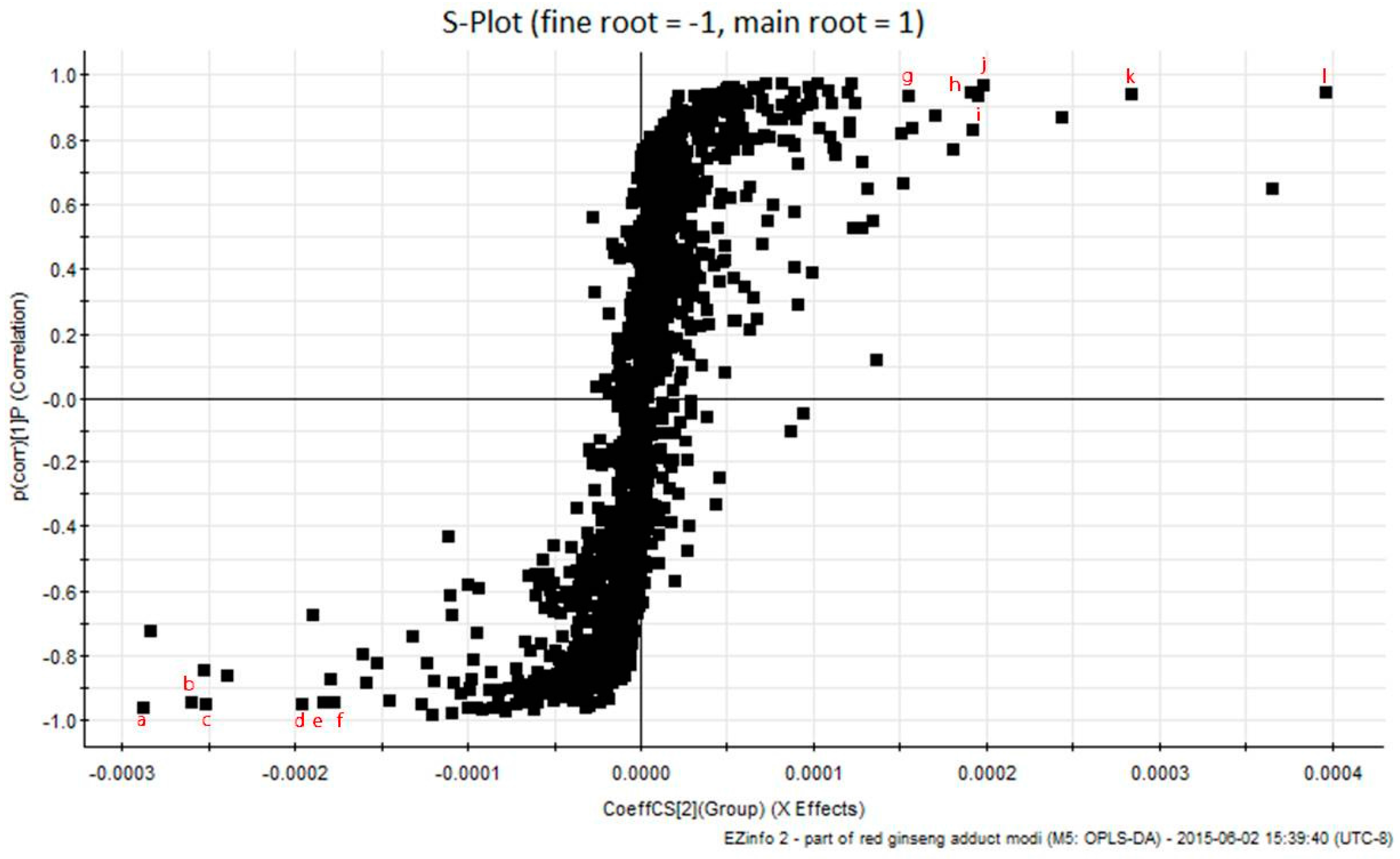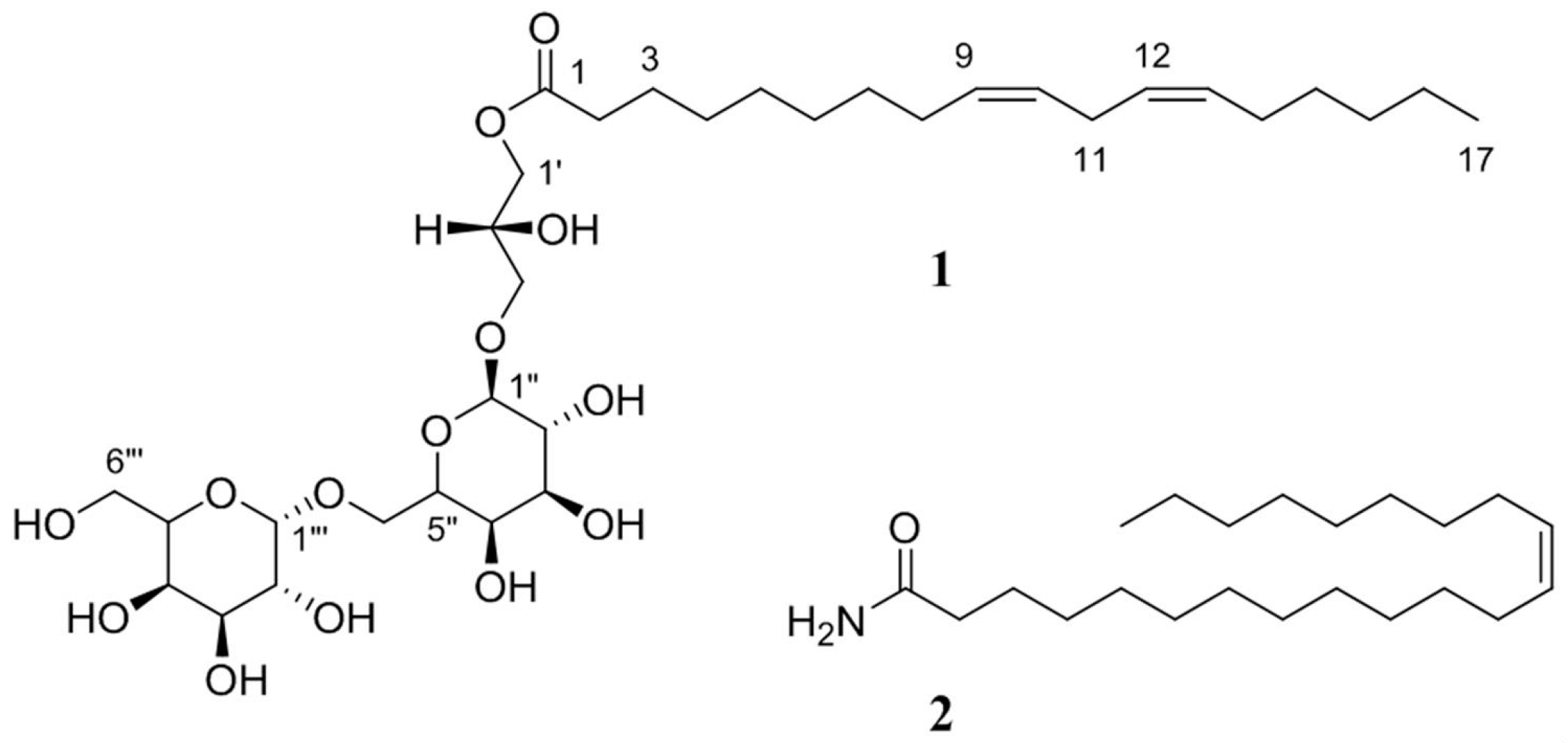A Metabolomic Approach for the Discrimination of Red Ginseng Root Parts and Targeted Validation
Abstract
:1. Introduction
2. Results and Discussion
2.1. Non-Targeted Component Analysis
2.2. Targeted Validation of Ginsenosides
3. Materials and Methods
3.1. Plant Materials
3.2. Chemicals and Reagents
3.3. Sample Preparation for Metabolomics
3.4. UPLC-QToF Analysis
3.5. Multivariate Analysis
3.6. Ginsenoside Analysis
3.7. Isolation of Selected Markers
3.8. General Experimental Procedures for Compounds 1 and 2
4. Conclusions
Supplementary Materials
Acknowledgments
Author Contributions
Conflicts of Interest
References
- Christensen, L.P. Ginsenoside: Chemistry, Biosynthesis, Analysis and Potential Health Effects. Adv. Food Nutr. Res. 2008, 55, 1–99. [Google Scholar]
- Baeg, I.-H.; So, S.-H. The world ginseng market and the ginseng (Korea). J. Ginseng Res. 2013, 37, 1–7. [Google Scholar] [CrossRef] [PubMed]
- Choi, K. Botanical characteristics, pharmacological effects and medicinal components of Korean Panax ginseng C.A. Meyer. Acta Pharmacol. Sin. 2008, 29, 1109–1118. [Google Scholar] [CrossRef] [PubMed]
- Soldati, F. Biologically Active Natural Products; Panax ginseng, Standardization and Biological Activity; Cutler, S.J., Cutler, H.G., Eds.; CRC Press: New York, NY, USA, 2000; pp. 209–304. [Google Scholar]
- Zhang, H.-M.; Li, S.-L.; Zhang, H.; Wang, Y.; Zhao, Z.-L.; Chen, S.-L. Holistic quality evaluation of commercial white and red ginseng using a UPLC-QTOF-MS/MS-based metabolomics approach. J. Pharm. Biomed. 2012, 62, 258–273. [Google Scholar] [CrossRef] [PubMed]
- Yang, S.-O.; Shin, Y.-S.; Hyun, S.-H.; Cho, S.; Bang, K.-H.; Lee, D.; Choi, S.-P.; Choi, H.-K. NMR-Based metabolic profiling and differentiation of ginseng roots according to cultivation ages. J. Pharm. Biomed. 2012, 58, 19–26. [Google Scholar] [CrossRef] [PubMed]
- Kim, N.; Kim, K.; Lee, D.; Shin, Y.-S.; Bang, K.-H.; Cha, S.-W.; Lee, J.W.; Choi, H.-K.; Hwang, B.Y.; Lee, D. Nontargeted metabolomics approach for age differentiation and structure interpretation of age-dependent key constituents in hairy roots of Panax ginseng. J. Nat. Prod. 2012, 75, 1777–1784. [Google Scholar] [CrossRef] [PubMed]
- Harkey, M.R.; Henderson, G.L.; Gershwin, M.E.; Stern, J.S.; Hackman, R.M. Variability in commercial ginseng products: An analysis of 25 preparations. Am. J. Clin. Nutr. 2001, 73, 1101–1106. [Google Scholar] [PubMed]
- Shi, W.; Wang, Y.; Li, J.; Zhang, H.; Ding, L. Investigation of ginsenosides in different parts and ages of Panax ginseng. Food Chem. 2007, 102, 664–668. [Google Scholar] [CrossRef]
- De Souza, L.R.; Jenkins, A.L.; Sievenpiper, J.L.; Jovanovski, E.; Rahelic, D.; Vuksan, V. Korean red ginseng (Panax ginseng C.A. Meyer) root fractions: Differential effects on postprandial glycemia in healthy individuals. J. Ethnopharmacol. 2011, 137, 245–250. [Google Scholar] [CrossRef] [PubMed]
- Yoshikawa, M.; Yamaguchi, S.; Kunimi, K.; Matsuda, H.; Okuno, Y.; Yamahara, J.; Murakami, N. Stomachic principle in ginger III, An anti-ulcer principle, 6-ginsgesulfonic acid, and three monoacyldigalactosylglycerols, gingerglycolipids A, B, and C, from Zingiberis Rhizoma originating in Taiwan. Chem. Pharm. Bull. 1994, 42, 1226–1230. [Google Scholar] [CrossRef] [PubMed]
- Shin, J.-S.; Park, H.-W.; In, G.; Seo, H.K.; Won, T.H.; Jang, K.H.; Cho, B.-G.; Han, C.K.; Shin, J. Metabolomic Approach for Discrimination of Four- and Six-Year-Old Red Ginseng (Panax ginseng) Using UPLC-QToF-MS. Chem. Pharm. Bull. 2016, 64, 1298–1303. [Google Scholar] [CrossRef] [PubMed]
- Park, H.-W.; In, G.; Kim, J.-H.; Cho, B.-G.; Han, G.-H.; Chang, I.-M. Metabolomic approach for discrimination of processed ginseng genus (Panax ginseng and Panax quinquefolius) using UPLC-QTOF MS. J. Ginseng Res. 2014, 38, 59–65. [Google Scholar] [CrossRef] [PubMed]
- Murakami, N.; Morimoto, T.; Imamura, H.; Ueda, T.; Nagai, S.-i.; Sakakibara, J.; Yamada, N. Studies on glycolipids. III. Glyceroglycolipids from an axenically cultured Cyanobacterium, Phormidium tenue. Chem. Pharm. Bull. 1991, 39, 2277–2281. [Google Scholar] [CrossRef] [PubMed]
- Park, H.-W.; In, G.; Han, S.-T.; Lee, M.-W.; Kim, S.-Y.; Kim, K.-T.; Cho, B.-G.; Han, G.-H.; Chang, I.-M. Simultaneous determination of 30 ginsenosides in Panax ginseng preparations using ultra performance liquid chromatography. J. Ginseng Res. 2013, 37, 457–467. [Google Scholar] [CrossRef] [PubMed]
- Sample Availability: Samples of the compounds ethanol extract of red ginseng each parts are available from the authors.




| Marker Ion | Retention Time (min) | Mass to Charge Ratio (m/z) | Identification | |
|---|---|---|---|---|
| Markers for fine root | Ion a | 18.26 | 425.3798 | Ginsenoside Rd |
| Ion b | 16.52 | 425.3784 | Ginsenoside Rc | |
| Ion c | 17.13 | 407.3690 | Ginsenoside Rb2 | |
| Ion d | 15.94 | 425.3777 | Ginsenoside Rb1 | |
| Ion f | 15.18 | 423.3632 | Ginsenoside 20(S)-Rg2 | |
| Markers for Main root | Ion g | 27.97 | 701.3853 | gingerglycolipid B (1) |
| Ion h | 27.72 | 520.3447 | unknown | |
| Ion k | 29.60 | 496.3431 | unknown | |
| Ion l | 39.33 | 338.3435 | 13-cis-docosenamide (2) |
| Analytes | Main Root | Lateral Roots | Fine Root | |
|---|---|---|---|---|
| PPT 1-type | NG 3-R1 | 0.03 ± 0.01 | 0.04 ± 0.01 | 1.39 ± 0.10 |
| G 4-Rg1 | 1.85 ± 1.13 | 2.91 ± 1.17 | 4.73 ± 0.60 | |
| G-Re | 2.12 ± 1.39 | 2.85 ± 0.86 | 8.88 ± 1.04 | |
| G-Rf | 0.54 ± 0.21 | 0.86 ± 0.25 | 1.45 ± 0.18 | |
| 20(S)-G-Rh1 | 0.85 ± 0.37 | 0.75 ± 0.27 | 1.22 ± 0.31 | |
| 20(S)-G-Rg2 | 0.14 ± 0.0543 | 0.30 ± 0.07 | 0.230± 0.31 | |
| 20(R)-G-Rg2 | 0.22 ± 0.10 | 0.20 ± 0.09 | 1.52 ± 0.55 | |
| G-Rg6 | 0.04 ± 0.03 | 0.05 ± 0.03 | 0.23 ± 0.04 | |
| G-Rk3 | 0.08 ± 0.04 | 0.06 ± 0.03 | 0.06 ± 0.02 | |
| G-F4 | 0.08 ± 0.03 | 0.14 ± 0.03 | 0.35 ± 0.06 | |
| G-Rh4 | 0.17 ± 0.08 | 0.14 ± 0.06 | 0.10 ± 0.03 | |
| Octillol-type | G-Ro | 0.25 ± 0.07 | 0.22 ± 0.05 | 0.14 ± 0.16 |
| PPD 2-type | G-Rb1 | 3.89 ± 1.68 | 7.91 ± 2.58 | 20.54 ± 3.56 |
| G-Rc | 1.15 ± 0.39 | 3.17 ± 0.99 | 9.27 ± 2.23 | |
| G-Ra1 | 0.04 ± 0.16 | 0.07 ± 0.33 | 4.78 ± 3.42 | |
| G-Rb2 | 1.46 ± 0.47 | 4.20 ± 1.28 | 11.33 ± 3.38 | |
| G-Rb3 | 0.26 ± 0.09 | 0.70 ± 0.22 | 2.10 ± 0.57 | |
| G-Rd | 0.12 ± 0.05 | 0.52 ± 0.21 | 2.46 ± 0.60 | |
| 20(S)-G-Rg3 | 0.12 ± 0.05 | 0.18 ± 0.06 | 0.48 ± 0.07 | |
| 20(R)-G-Rg3 | 0.08 ± 0.04 | 0.12 ± 0.04 | 0.27 ± 0.05 | |
| G-Rk1 | 0.07 ± 0.03 | 0.13 ± 0.04 | 0.28 ± 0.05 | |
| G-Rg5 | 0.63 ± 0.121 | 0.98 ± 0.21 | 1.59 ± 0.21 | |
| sum of PPT type | 6.10 ± 2.41 | 8.30 ± 2.41 | 15.90 ± 2.00 | |
| sum of PPD type | 7.82 ± 2.89 | 17.99 ± 5.29 | 53.10 ± 9.12 | |
| PPD/PPT | 1.30 ± 0.10 | 2.18 ± 0.26 | 3.34 ± 0.39 | |
© 2017 by the authors. Licensee MDPI, Basel, Switzerland. This article is an open access article distributed under the terms and conditions of the Creative Commons Attribution (CC BY) license ( http://creativecommons.org/licenses/by/4.0/).
Share and Cite
In, G.; Seo, H.K.; Park, H.-W.; Jang, K.H. A Metabolomic Approach for the Discrimination of Red Ginseng Root Parts and Targeted Validation. Molecules 2017, 22, 471. https://doi.org/10.3390/molecules22030471
In G, Seo HK, Park H-W, Jang KH. A Metabolomic Approach for the Discrimination of Red Ginseng Root Parts and Targeted Validation. Molecules. 2017; 22(3):471. https://doi.org/10.3390/molecules22030471
Chicago/Turabian StyleIn, Gyo, Hyun Kyu Seo, Hee-Won Park, and Kyoung Hwa Jang. 2017. "A Metabolomic Approach for the Discrimination of Red Ginseng Root Parts and Targeted Validation" Molecules 22, no. 3: 471. https://doi.org/10.3390/molecules22030471
APA StyleIn, G., Seo, H. K., Park, H.-W., & Jang, K. H. (2017). A Metabolomic Approach for the Discrimination of Red Ginseng Root Parts and Targeted Validation. Molecules, 22(3), 471. https://doi.org/10.3390/molecules22030471





